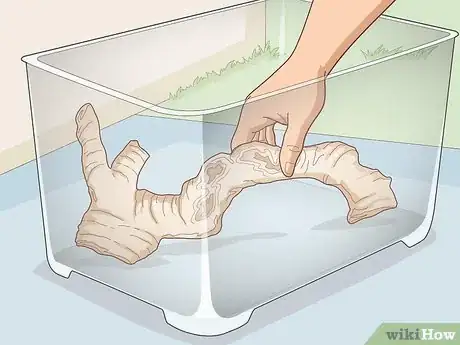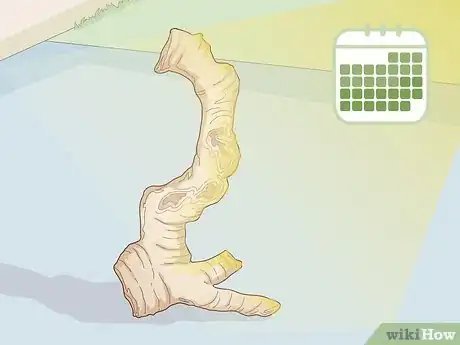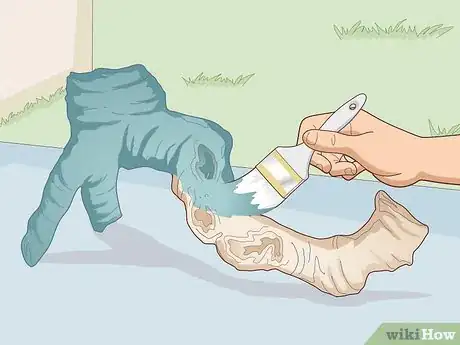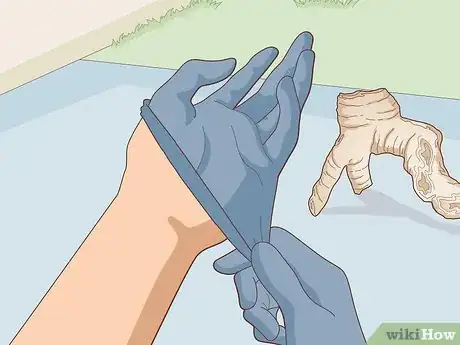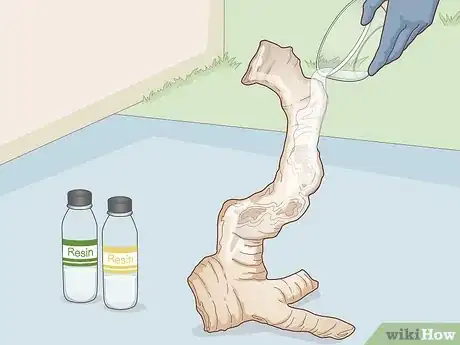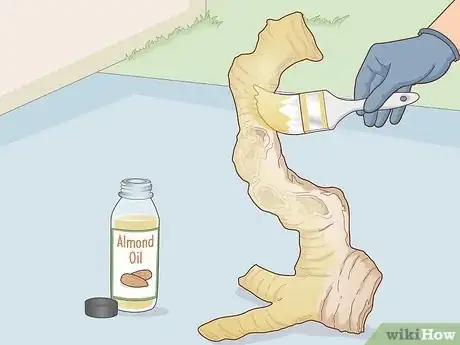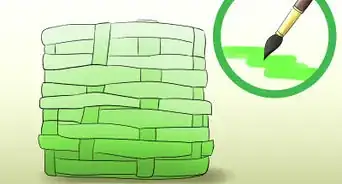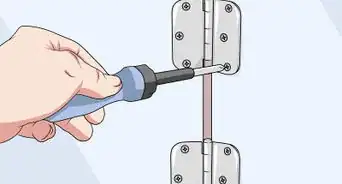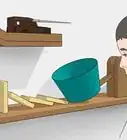This article was co-authored by wikiHow staff writer, Eric McClure. Eric McClure is an editing fellow at wikiHow where he has been editing, researching, and creating content since 2019. A former educator and poet, his work has appeared in Carcinogenic Poetry, Shot Glass Journal, Prairie Margins, and The Rusty Nail. His digital chapbook, The Internet, was also published in TL;DR Magazine. He was the winner of the Paul Carroll award for outstanding achievement in creative writing in 2014, and he was a featured reader at the Poetry Foundation’s Open Door Reading Series in 2015. Eric holds a BA in English from the University of Illinois at Chicago, and an MEd in secondary education from DePaul University.
There are 16 references cited in this article, which can be found at the bottom of the page.
This article has been viewed 62,100 times.
Learn more...
There’s something so elegant and beautiful about driftwood. It spends days, months, or even years just floating around in the water before washing up on the shore with this beautiful texture and grain. It’s no wonder that natural driftwood is such a popular choice for sculpting, woodworking, and painting. You can even use a raw piece of driftwood as an accent piece on the wall or as a unique centerpiece. Preserving driftwood isn’t particularly difficult, but it does take some time and patience. You can either clean and bleach it to preserve it in its natural state, or go the extra step to seal it in oil, resin, or varnish to preserve it in a protective coating.
Steps
Cleaning and Prepping the Wood
-
1Remove any weakened branches or cracked pieces if you want to clean it up. How you prep your driftwood for preservation depends on what you’re using the driftwood for. If you want to clean the driftwood up, remove any weakened pieces of the driftwood. Either put on gloves and remove the pieces by hand, or use a chisel or scraping tool to break off the sections you want to remove.[1]
- You may want to do this if you’re preserving a single piece of natural driftwood or don’t want any weak chunks of wood snapping off when you’re sculpting it.
-
2Sand the wood if you want to smooth your piece out. To smooth the wood out, grab a sheet of 180- to 300-grit sandpaper. Put on a set of thick work gloves. You can sand the surface of the wood by hand, or use an orbital sander to remove the exterior layer of wood. This will give your driftwood a smooth, soft texture.[2]
- The amount of pressure you use when sanding is totally up to you. The harder you press the sandpaper into the wood, the smoother the finish will be. Some people prefer the look of rougher driftwood, though.
- Don’t forget the other side of the wood. If you’re sanding one side of the wood, you should sand the other side as well to make it consistent.
Advertisement -
3Knock the dirt, sawdust, and residue off with a brush and air compressor. Take your driftwood outside and grab a stiff-bristled brush. Scrub the wood with the dry brush to knock off any dust, dirt, or weak layers of wood. Use an air compressor to blow the wood dust and debris off. The more dirt, sand, and debris you can knock off, the more effective the bleaching process will be.[3]
- You can use some canned air instead of the compressor if you don’t have one.
- Make sure that you scrub and blow air on the opposite side of the wood, too!
Bleaching and Drying the Wood
-
1Place the driftwood in a plastic bin big enough to submerge it. Get a plastic trash can or storage bin that is big enough to hold your chunk of driftwood. You’re going to fill this bin with water and bleach, so make sure that you have at least 6–12 inches (15–30 cm) of space at the top. Gently set the driftwood in the bottom.[4]
- Do this outside if possible. The bleach fumes can be obnoxious and you’ll soak your wood for a few hours. If it may rain, wait for a clear, sunny day to do this.
-
2Submerge the driftwood in a solution of bleach and water. If you want to dye the driftwood white, fill your bin with a solution of 9-parts water and 1-part bleach.[5] If you want to preserve the original color and grain, use 1 cup (240 mL) of bleach for every 5 gallons (19 L) of water instead. Fill the bin with enough of your bleach solution to completely submerge the driftwood.[6]
- Wash your hands thoroughly with soap and water if you get any bleach on your skin.
Tip: You have to do this if you want to preserve the driftwood. The bleach kills off any bacteria or pests that are hiding inside of the wood. Bugs and bacteria tend to build up inside driftwood, which will cause it to rot over time. Bleaching and cleaning the wood removes all of that junk.
-
3Place a heavy tile or brick on top of the driftwood if it floats. Driftwood tends to be buoyant and it may float to the surface of the bin if you don’t have a particularly heavy piece of wood. If this happens, place a ceramic tile, brick, or some other heavy object on top of the driftwood. The entire piece of wood must be submerged for this process to work.[7]
-
4Let the driftwood soak for at least 6 hours to kill the bugs and bacteria. Let the bin sit out in the open air for at least 6 hours. This should be more than enough time to remove the bacteria and pests living in the wood. However, if you want to dye the wood white, leave wood in the bleach and water for as long as it takes to change color. If you have to let it soak for more a day, change the bleach and water solution out after 24 hours.[8]
- The longer you leave the wood, you whiter it will turn. You’ll get diminishing returns after 3-4 days, though.
- The younger the wood is, the longer it takes to change color. You may need to keep the wood submerged for 2-3 days to dye it white.
-
5Let the driftwood air dry for 24 hours before rinsing them off. Put on a pair of nitrile gloves and carefully lift the wood out of the solution. If it’s a bigger piece, pour the water and bleach out into a dirt patch or large sink to retrieve the wood. Pull the wood out and let it sit on the driveway, sidewalk, or some other solid surface. Let it rest in the sun for at least 24 hours before rinsing the wood thoroughly with a hose.[9]
- This will give the bleach time to dissipate into the wood, which will preserve it for longer.
- When rinsing the wood, you can use cold or warm water. Either way, be sure to really soak the wood. It’s key to washing off any bleach residue that sticks to the external surface, which you don’t want.
-
6Dry the driftwood for 15-30 days in the sun to fully let it cure. After you’re finished rinsing the wood, let it sit out in the sun for at least 15 days. This will give the moisture trapped inside of the wood time to completely dissipate. On days when it may rain or snow, take your wood inside and let it dry in the garage, basement, or the corner of some unused room.[10]
- You can stop here if you’d like. Driftwood that has been cleaned and bleached should hold up just fine for years before it starts to flake or fall apart.
Sealing Your Driftwood
-
1Finish your wood after you’ve done any optional woodworking or painting. If you’re using your driftwood for an art project or sculpture, go ahead and do your work now. Sealing the wood in an epoxy resin will preserve anything underneath it, so you need to complete that fun woodworking or art project before first before doing this.[11]
- You don’t need to do anything to the wood if you don’t want to. Many people enjoy using raw pieces of driftwood as a centerpiece on a table or as an accent piece on a bare wall.
-
2Put on some nitrile gloves to protect your hands. Regardless of the finish that you choose, it’s best to keep your hands clean while you work. This is particularly important if you’re using an epoxy resin to finish the driftwood, since it’s usually spread out by hand.[12]
- These finishes aren’t toxic, but you can put a dust mask on if you tend to be bothered by the smell of chemicals.
-
3Use a 2-part epoxy resin if you want a thicker, stronger finish. Mix the 2 epoxies together in a plastic bowl or cup. Tilt your bowl or cup over any end of the driftwood to pour out a thin bead of the epoxy. Move the bowl or cup toward the other end of the wood to spread a thick bead over the surface. Either spread the epoxy out by hand or use a brush to move it over the wood until you’ve applied a thin layer of resin.[13]
- Let the resin dry for at least 72 hours to fully cure to the wood.
- The thicker the epoxy layer is, the more plastic and reflective your wood will look. Some people really like this look, while others prefer to keep the wood looking as natural as possible.
- The driftwood should last for decades. Epoxy resin is actually what builders use to repair antique wood in historic homes, so there’s plenty of evidence that your wood will hold up just fine over time.[14]
-
4Opt for a wood varnish or stain to change the color of the wood. Any varnish or stain that you can use on other types of wood can be applied to driftwood. Varnish tends to leave a slicker finish behind while stains will actively change the color of the wood. Get a varnish or stain and follow the manufacturer’s instructions to apply it to your wood. Typically, this is done by applying 2-3 layers of the liquid with a paint brush.[15]
- Wait 48 hours for the wood to completely dry after applying a varnish or stain.
- Driftwood is extremely porous—even more so than other varieties of wood. It may take multiple layers of a thinner varnish or stain to actually see the layer on the surface of the wood.
- Using a varnish or stain will protect the driftwood from surface scratches and minor wear and tear.
-
5Choose a furniture oil or liquid wood wax to preserve the natural appearance. Furniture oil will leave a thinner texture on the wood, while wood wax will build up on the surface and harden. Use either of these options to maintain the natural grain and color of the wood. Follow the manufacturer’s instructions on the label to apply a wax or oil. Typically, you use a brush to apply thin layers and build them up on the surface as needed.[16]
- Wait 48-72 hours after applying a furniture or wax to give the wood time to dry.
Warnings
- Bleach is a skin irritant. Wash your skin thoroughly with soap and water if it gets on your skin. Keep your eyes away from the bleach when you’re pouring or mixing it, since it can impair your vision or cause blindness.[17]⧼thumbs_response⧽
Things You’ll Need
Cleaning and Prepping the Wood
- Brush
- Compressed air
- Gloves
- Chisel (optional)
- Sandpaper (optional)
- Orbital sander (optional)
Bleaching and Drying the Wood
- Water
- Plastic bin
- Bleach
- Nitrile gloves
Sealing Your Driftwood
- Plastic sheet or trash bag
- Nitrile gloves
- Brush
- Wood finish
- Water
References
- ↑ https://youtu.be/73Uqk3zOvOA?t=210
- ↑ https://youtu.be/jRyCObIUsxs?t=82
- ↑ https://youtu.be/SocvyByxfRc?t=47
- ↑ https://youtu.be/SocvyByxfRc?t=141
- ↑ https://youtu.be/SocvyByxfRc?t=150
- ↑ https://youtu.be/1AIvUIFCuA8?t=149
- ↑ https://youtu.be/SocvyByxfRc?t=192
- ↑ https://youtu.be/1AIvUIFCuA8?t=210
- ↑ https://youtu.be/1AIvUIFCuA8?t=217
- ↑ https://youtu.be/1AIvUIFCuA8?t=249
- ↑ https://youtu.be/zPsrZX0Hvy0?t=752
- ↑ https://youtu.be/R2s-NMwEn0k?t=555
- ↑ https://youtu.be/zPsrZX0Hvy0?t=880
- ↑ https://repository.upenn.edu/cgi/viewcontent.cgi?article=1554&context=hp_theses
- ↑ http://driftwoodforsale.co.za/how-to-treat-driftwood-cleaning-treatment-and-finishing-driftwood/
- ↑ http://driftwoodforsale.co.za/how-to-treat-driftwood-cleaning-treatment-and-finishing-driftwood/
- ↑ https://wspehsu.ucsf.edu/wp-content/uploads/2015/10/FactSheet_Bleach.pdf



